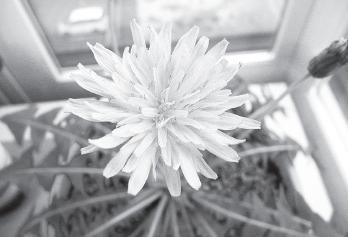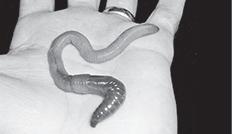
10 minute read
Liberty
By Colletta Kosiba Hendricks County Master Gardener
Commercials have you believing the dandelions are worse than Covid.
Advertisement
If you are one of the insects like bees, that need pollen and nectar to begin life in the spring, you welcome the humble dandelion that provides both. Take a close look at the flowers this spring and you will see what I mean!
Dandelions were originally brought to the U.S. by the first Europeans, to add them to their herb gardens to be sure they had spring greens and for their medicinal value. In fact, the family of plants that the dandelion belongs to includes lettuce. Dandelions were world-famous for their beauty. They were a common and beloved garden flower in Europe. They are the subject of poems.
Dandelions were grown for their medicinal properties.by early settlers.
Dandelions are more nutritious than most of the vegetables in your garden. The plant was named after lions because their lion-toothed leaves. leaves have more vitamin A than spinach, more vitamin C than tomatoes, and are a lot of iron, calcium and potassium.
Dandelions products are among the most expensive items in the grocery store.
Having escaped the herb gardens a many decades ago, dandelions seem to be on a quest to get back into the yards they once abandoned.
Dandelions are good for your lawn: 1. wide-spreading roots loosen hard-packed soil, aerate the earth and help reduce erosion. 2. the deep taproot pulls nutrients such as calcium from deep in the soil.making them available to other plants. 3 most folks think they’re a lawn killer, they actually fertilize the grass as they decompose.
Herbicides used on lawns to kill dandelions take a terrible toll on wildlife. More than seven million wild birds are estimated to die annually Remember there’s a safer way to have a dandelion-free lawn!
Let the grass grow 3 or 4 inches tall to shade out the sun-loving dandelions. When you scalp your grass, you let in more light for the dandelions to grow.
Dandelions are only flower a kid can pick without getting into trouble. In a field full of dandelions, kids never run out of things to do: Blowing on dandelion to see the seed disperse, or can tell you how many years until you get married, or how many children you’ll have! If you catch a flying dandelion seed, you can make a wish!!!
Dandelions are masters of survival and may never be eradicated, but we learn to be more at ease with dandelions and other wild things – and maybe even love them a little.

From Hendricks County Extension Homemakers Clubs
In 2022 The Republican is introducing a new feature: weekly recipes from members of Hendricks County Extension Homemakers Clubs. Each month members of one of the clubs will submit a favorite recipe for our readers to try.
This recipe from the Indiana Extension Homemakers Associaton ‘s A Happy Homemakers Club reflects the history and passion for the art of homemaking that makes our club so Happy. If you would like to join our celebrations of the home, contact the Hendricks County IEHA office at 317-745-9260
HARD ROCK CANDY Submitted by Patty Ramsey
1 cup light corn syrup ½cup water 2 cups white sugar 1 small bottle flavor oil few drops food color
Put syrup, sugar, and water in a heavy pan. Cook to hard crack stage on a candy thermometer (280°). Remove from heat and stir in flavor oil and food coloring. Quickly poor mixture onto prepared pans.
Prepare pans (I use round pizza pans) by covering with powdered sugar. After covering pan with candy mixture, sprinkle more powdered sugar on top.
Let cool just a few minutes, then score candy in a 1” grid (approximatley) using a pizza cutter. Let cool. Break candy into small pieces.
I use cinnamon flavor & red food color, sassafras & yellow-orange food color, peppermint & blue food color, and green with spearmint. You can make your own choices.
This was a favorite Christmas candy my mother made. I have made it for gifts for many years. ______________________________________________
Exploring Hendricks County
By Jackie Horn

European (good worms) have a reddish brown and raised clitellum, the band aroind the middle.
____________________________________________________ Earthworms
I love spring. I look forward to warmer weather, green grass, and flowers. What I don’t relish is the dreaded “Worm Rain.” You know what I’m talking about. The temperature has warmed up and it rained overnight. You wake up, head out for a walk, or to get the paper, and the sidewalks and paved driveways are covered in icky, smelly earthworms. Blek! There are so many it’s difficult to not step on them. And the smell!
Even though they’re disgusting, worms are fascinating and very beneficial. There are over 7,000 species of earthworms. They range in size from an inch long to two yards (72 inches!) and can be found in most temperate and tropical soils and at all depths. Worms are hermaphrodites which means they have both male and female characteristics. Some species don’t even need another worm to reproduce. Earthworms don’t have lungs but breathe through their skin. They don’t have eyes but they “see” light through photosensitive cells. Worms have blood and depending on the species, it can be red, colorless, or green. The family of earthworms that is most beneficial in Indiana are Lumbricidae. There are very few “native” earthworms in North America. Most were frozen out by the glaciers during the last ice age. Most of the species we know now were brought over with early European settlers.
How are worms good? The earthworms we’re used to seeing are beneficial because they make the soil better. Dead and decomposing matter is “sucked” into the mouth. Muscular walls draw the material in where it is broken down by the gizzard and moved along into the intestine. There enzymes are added and nutrients digested. What remains is then “poop out” as castings. The castings contain even more soil-enriching microorganisms than were originally consumed. That’s pretty impressive but wait, there’s more! Not only do they make soil, they mix it into the existing dirt, improving the quality by burrowing. Worms can turn over the top six inches of soil every ten to twenty years.
While they’re busy burrowing, worms are making the soil more porous. As the ground becomes more permeable, it is better able to absorb heavy rainfall and reduce erosion. The channels also make it easier for plants to take root and have a ready source of nutrients in the casting left by the worm.
Recently another worm has shown up in the neighborhood, Amynthas a.k.a. Crazy Snake Worms or Asian Jumping Worms. They’re called “jumping” because when touched, they squirm, wriggle, and “jump” even more than normal worms.
These worms are posing problems for our traditional worms as well as salamanders and other critters in the soil. Jumping Worms live closer to the surface and don’t burrow like traditional earthworms. The Asian Worms reproduce and move much faster. While European earthworms move about 30-feet per year, Asian worms can spread over 17 ACRES The Amynthas or Asian in one season, damaging Jumping Worm have a flush, root systems and replacing white or light gray clitellum which completely encircles the traditional species as they worm’s body. (Photo from Plant go. They breakdown leaf and Pest Diagnostic Lab) litter and debris but because they live near the surface, the castings aren’t mixed into the existing soil. Their castings are coarser and remain on the surface to wash away, never making it to plant roots.
The signs of an infestation include a large area where the vegetation has died away and leaf debris is gone. The soil appears dry, grainy and looks like coffee grounds (Amynthas’ castings). If the soil surface is scratched or raked, the earthworms will be visible, writhing and thrashing.
If you think you have an infestation of the invasive Asian Jumping Worms, check out the internet for tips on positively identifying the worm and report it to reportinvasive.com. While completely eradicating the worms is difficult, covering the area with plastic and letting the sun “bake” it at 105 degrees for 30 minutes will destroy the adults and put a dent in the number of egg cocoons. But back to the Worm Rain. Why do they leave their underground burrows and end up on the sidewalks? There are a few theories. My favorite is the vibrations of a hard rain hitting the ground confuses the worms into believing a predator, such as a mole, is heading their way. They need to escape their burrow fast. The worm digs up to the surface. (Birds have been observed striking the ground to create vibrations and tricking worms into surfacing.) We only see the worms that crawl onto the sidewalk. There are more in the grass...waiting to be stepped on. Ewwww!

Memories of Past Times
[A reader sent in this essay by her father. We many of our many present-day readers will remember along and enjoy.]
WASH DAY
By Alton West Hinshaw (1926-2010)
Long before electricity and running water came to the farm in Zionsville, Ind. Mother truly had to labor to keep her family in clean clothes. Mondays were Mother’s washday but Sunday evening was her sons fill up tubs time. Our home life was different than today for we lived at the end of the depression (after 1941), with wood chopping, water carrying, wood heating, and soap making. Wood had to be cut and split then carried in to the supply box to keep the warm morning stove going all day.
Hard water drawn from a hand-dug well mostly filled with suffice rainwater. It was fine to drink as it was but detested for doing laundry. The wood heating warm morning stove reservoir was to be filling to the top with water, plus there was boiler placed on the stove and filled. The boiler was set on the stove after the morning meal was over. Two number 2 tubs were filled with water for rinsing the clothes after they were washed. Soap added to mineral-laden well water left the liquid curdling like sour milk. Sometimes, Mother added two spoons of red lye directly to the boiling tub to soften the water, cautioning us to stand back while she did so. After a layer of scum formed, she skims it off with a large metal spoon. Softened in the process, the water became usable.
If course there were soft water, it was call rainwater. That also required extra effort on Mother’s part as well. She scanned the sky for any sign of rain, placing wooden barrels and buckets under the eaves of the roof of the house, catching us much rainwater as possible. Rain was precious. Mother made sure we caught every drop we could. We had much fun after the rain set in, we would watch when it first started then games were in order. It was great for washing her and my sisters’ long hair - and our clothes, too, when there were enough.
If water stood too long in the summer, you had to remove the mosquito larva, which we kids called “wiggle-tails”. Mother strain the contaminated water though a pillowcase then boiled it.
Occasionally, Mother bought laundry soap “Oxodol” (I think this was the first granulate soap). More commonly, though, she made her own lye soap. She saved every bit of fat from butchering day, rendering it in the kitchen stove oven to clarify it before making soap. On the big day, she added lye in the cool water, which caused it to heat. She heated the fat to the exact same temperature testing it with the candy thermometer until it reached 98 degrees, then poured the lye combination into the fat.
To be successful, she said, the mixture had to be stirred slowly and evenly every half-hour. Later, in a shallow box lined with heavy waxed paper, the soap that resulted cooled and solidified.
Heavily soiled items required an overnight soaking before Mother attacked them with her soap and scrub board. Afterward, white articles were dropped into the wash boiler to bubble their way to spotlessness. The old wash boiler had multiple uses, Clothes, soaking chickens for cleaning or dressing and heating bath water.
Once laundry was boiled, Mother removed them by a stick and rinsed them in the cool water, wrung out each item by hand and repeated it again in the second tub of cool water. Hanging most things out to dry on a “SAE 9 galvanized wire” clothesline strung between two maple trees. Then finally, she could relax for a short time before the next meal. Confident we would have clean clothing for the next week.








